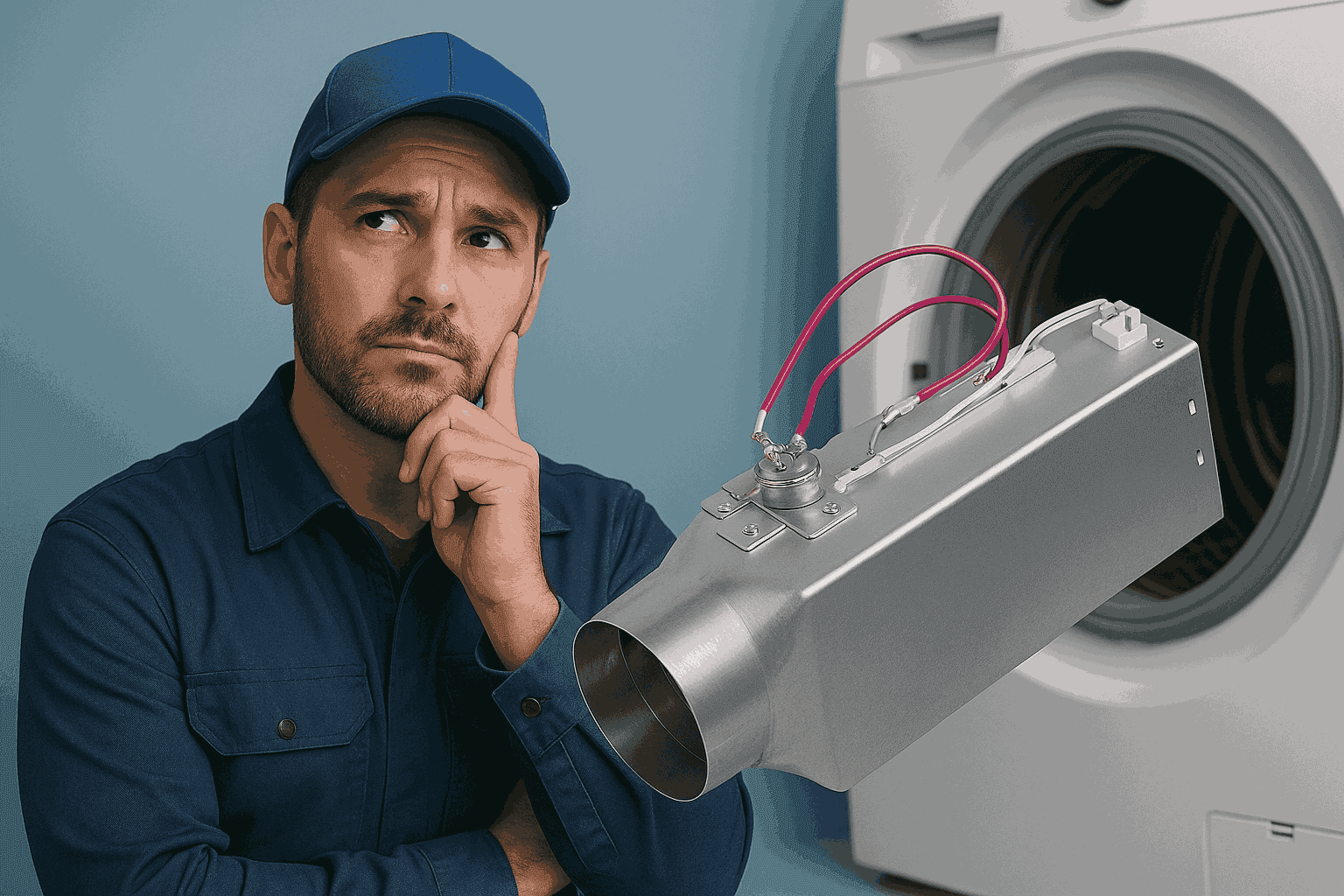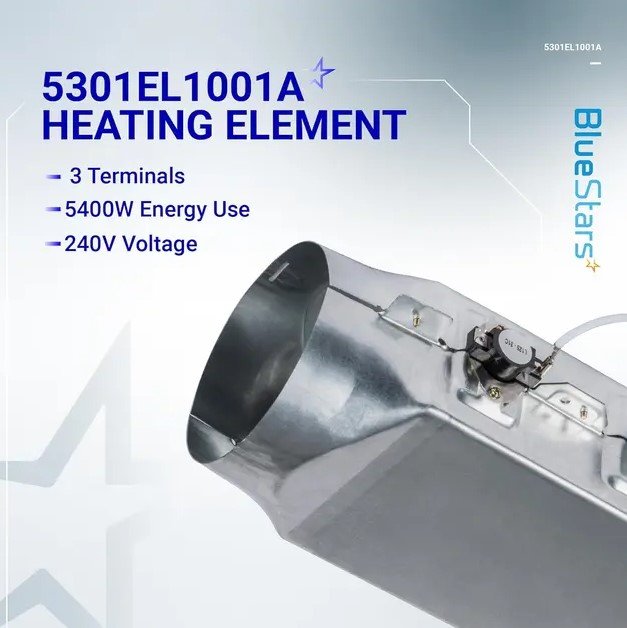Review
Is It Worth Replacing a Heating Element in a Dryer?
AZparts Team
Updated on December 31, 2025
8 min read
When your dryer stops generating heat, the culprit is often a faulty heating element. This critical component is responsible for warming the air that dries your clothes. With rising appliance costs, many homeowners face a crucial decision: Is it worth replacing a heating element in a dryer, or should you invest in a new machine altogether? This comprehensive guide from AZParts will help you make an informed decision based on cost, efficiency, and practical considerations.

1. Signs of a Broken Heating Element in Your Dryer
Identifying a faulty heating element early can prevent additional damage to your dryer and save you from unexpected laundry disruptions. Here are the most common indicators that your dryer's heating element might need replacement:
- Clothes Remain Damp After a Complete Cycle: The most obvious sign is when clothes stay wet after a full drying cycle because the malfunctioning heating element fails to generate enough heat to dry your garments.
- Extended Drying Times: A deteriorating heating element produces less heat, forcing your dryer to run significantly longer than normal to achieve the same results.
- Dryer Runs But Produces No Heat: When your dryer tumbles normally but generates no heat whatsoever, this strongly indicates a completely failed heating element.
- Inconsistent Heating: A partially damaged heating element causes temperature fluctuations that result in some clothes being completely dry while others remain damp in the same load.
- Unusual Burning Smell: A distinct burning odor during operation often signals the heating element is failing as its coils break down or accumulated dust and lint begin to burn.

If you experiencing these symptoms, you should get a new dryer heating element (Source: AZParts)
If you're experiencing these symptoms, it's time to consider a heating element replacement. AZParts offers reliable replacement heating elements for major dryer brands, including the popular Dryer Heating Element 5300W 240V that's compatible with LG models.
Check out more: How to Fix the Heating Element in a Dryer
2. How to Tell If Your Dryer’s Heating Element Is Failing
Before investing in replacement parts, confirm that the heating element is indeed the problem. Here's how to properly diagnose a failing heating element:
2.1. Visual Inspection
For most dryers, you can inspect the heating element by:
- Disconnecting the power to ensure safety
- Accessing the element (typically located at the rear of the dryer)
- Examining the coils for visible breaks, burns, or blistering

Disconnecting the power for your safety (Source: AZParts)
A heating element in good condition should have intact coils without any visible damage. Breaks in the coil indicate a definite need for replacement.
2.2. Continuity Testing
If visual inspection is inconclusive, test the heating element's continuity using a multimeter:
- Completely disconnect the dryer from power
- Remove the heating element assembly
- Set your multimeter to measure resistance (ohms)
- Touch the probes to the element's terminals

Continuity testing by removing the heating element assembly (Source: AZParts)
A functional heating element should show some resistance reading (typically between 10-50 ohms depending on the model). If your multimeter shows "infinite" resistance or an open circuit, the element is broken and needs replacement.
2.3. Rule Out Other Components
Before concluding that the heating element is faulty, verify that other components aren't causing similar symptoms:
- Check that the thermal fuse hasn't blown
- Ensure the high-limit thermostat is functioning
- Verify the timer or electronic control board is correctly cycling to heat
- Confirm the heating element relay isn't stuck in the open position
Some of these components are designed as safety features that prevent the heating element from activating under certain conditions, so they might be the actual cause of your no-heat problem.
2.4. Temperature Output Testing
For gas dryers, which use a heating element for ignition rather than as the primary heat source, you can test temperature output:
- Run an empty dryer on high heat
- After 5-10 minutes, carefully open the door
- Use a heat-resistant thermometer to measure air temperature

Run an empty dryer on high heat (Source: Freepik)
If temperatures are significantly below manufacturer specifications (typically 120-160°F), your heating element may be underperforming even if not completely failed.
3. Is It Worth Replacing a Heating Element in a Dryer?
The decision to replace a heating element requires weighing several factors to determine if it's economically sensible. Consider these key points when making your decision:
3.1. Cost: Replacement Parts vs. New Dryer
In 2025, the average cost of a heating element ranges from $40-$100 depending on your dryer's make and model. Professional installation typically adds $100-$200 to this cost, bringing the total repair expense to approximately $140-$300.
In contrast, new dryers in 2025 cost:
- Basic models: $400-$600
- Mid-range models: $600-$900
- High-end models: $900-$1,500+
When the repair cost approaches 50% of the replacement cost, many experts suggest considering a new appliance. For most heating element replacements, the repair represents only 15-30% of a new dryer's cost, making replacement economically sensible.

Is It worth replacing a heating element in a dryer (Source: Pinterest)
Check out more: How Much Does It Cost to Replace a Dryer Heating Element?
3.2. Age and Condition of Your Dryer
The average lifespan of a modern dryer is 10-13 years. Consider these guidelines:
- Dryers under 5 years old: Almost always worth repairing
- Dryers 5-8 years old: Generally worth repairing if no other significant issues exist
- Dryers 8-10 years old: Worthy of repair if in otherwise good condition
- Dryers over 10 years old: Carefully weigh repair costs against remaining lifespan
If your older dryer has already required multiple repairs, investing in yet another fix might not be cost-effective in the long run.
3.3. Energy Efficiency Considerations
Newer dryer models offer significant energy efficiency improvements over models from even 5 years ago. The Department of Energy estimates that ENERGY STAR certified dryers use approximately 20% less energy than standard models.
If your current dryer is an older, less efficient model, the cumulative energy savings from upgrading might eventually offset the higher initial investment of a new machine. However, simply replacing a heating element won't improve your existing dryer's efficiency ratings.
3.4. Availability of Replacement Parts
For obscure brands or discontinued models, finding compatible parts might become increasingly difficult, potentially making a new purchase more practical for long-term reliability.
The continued availability of compatible parts should factor into your decision. For popular brands and models, AZParts provide numerous heating element parts that ensure your repair investment won't be wasted due to future parts scarcity.

AZParts stocks numerous heating elements for your repairing process (Source: AZParts)
3.5. Environmental Impact
Repairing your existing dryer rather than replacing it reduces landfill waste and the environmental cost of manufacturing a new appliance. A simple component replacement like a heating element represents a significantly smaller carbon footprint than producing an entire new appliance.
4. Should You Repair or Replace Your Dryer?
Facing dryer heating element issues? Understanding when to repair versus replace is essential for homeowners seeking cost-effective appliance solutions. Key decision factors include your dryer's overall condition, repair frequency, and parts availability—all critical considerations before investing in either heating element replacement or a brand-new appliance.
For dryers under 10 years old with minimal repair history and readily available replacement components, installing a new heating element delivers exceptional value. Conversely, appliances exceeding the decade mark with recurring maintenance needs or discontinued parts typically warrant complete replacement, offering improved energy efficiency, advanced features, and long-term reliability benefits.
Stacked washer-dryer configuration compatibility presents additional considerations for homeowners evaluating repair versus replacement options. Dimensional variations between manufacturers and models may prevent newer dryers from properly integrating with existing washing machines, potentially necessitating heating element repair rather than complete replacement to maintain your current laundry setup.

Should you repair or replace your dryer? (Source: AZParts)
5. FAQs about Replacing a Heating Element in a Dryer
5.1. Do older dryers justify a new element?
Replacing heating elements is typically cost-effective for dryers under 8 years old, worthwhile for 8-10 year machines in good condition, but requires careful evaluation for dryers exceeding 10 years. The decision should factor in the dryer's original quality, as premium brands may justify element replacement even at advanced ages due to superior build quality and longer expected lifespan, while budget models may not warrant significant investment after 7-8 years of service.
5.2. Is it easy to replace the heating element in a dryer myself?
DIY heating element replacement difficulty varies by model, easiest for top-loaders (accessible from back), moderate for front-loaders (more disassembly required), and most challenging for compact/stacked units due to space constraints. The process typically involves removing panels, disconnecting terminals, unbolting and replacing the element, and reassembling, taking 1-2 hours for beginners, with manufacturer-specific tutorials greatly simplifying the task for successful outcomes.
5.3. Will a new element restore full heat?
In most cases, replacing a failed heating element will fully restore your dryer's heating capability to its original performance. However, if reduced heating was caused by multiple factors, additional repairs might be necessary for complete restoration. For optimal performance after heating element replacement, also clean your dryer's ventilation system, as restricted airflow can reduce heating efficiency and place additional strain on the new element.
Deciding whether to replace your dryer's heating element hinges on appliance age, repair history, and overall condition. Typically, replacing the heating element is economically beneficial and can extend your dryer's life significantly. For high-quality, genuine replacement parts, AZParts offers a comprehensive selection of dryer parts engineered for perfect compatibility and optimal performance, ensuring reliable operation after installation. Explore reliable solutions and enhance your appliance’s longevity with AZParts today!
Contact Info
Address: 8 The Green, Ste A, Dover, Delaware 19901-3618, United States
Email: support@azparts.com
Dryer
Further Reading
Further Reading





